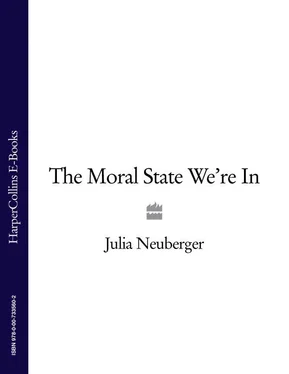But, for the inmates of these asylums, the regimes were cruel. There was annual bloodletting at the Bethlem and general use of strait jackets and purges. There were, however exceptions. One of the most distinguished was William Battie (1704-76), physician to the new St Luke’s Asylum in London, who also owned a private asylum. A small proportion of the insane did, in his view, suffer from incurable conditions; but the majority, he argued, had what he described as ‘consequential insanity’-derived from events that had befallen them-and for whom the prognosis was good. So instead of bloodletting, purges, surgical techniques (such as removing ‘stones’ from the brain, a particularly vile treatment), and restraint, what was needed was what he described as ‘management’-person to person contact designed to treat the specific delusions and delinquencies of the individual. Battie considered that ‘madness is…as manageable as many other distempers’. †
And so a humane period-relatively speaking-in the treatment of mental illness began. Amongst others, Francis Willis (1718-1807), who was called in to treat George III, pioneered a ‘moral management’ school of treatment, where the experienced therapist would outwit the patient. At Willis’s Lincolnshire madhouse everyone was properly dressed and performed useful tasks in the gardens and on the farm, with exercise being a key feature. Similarly, the York Retreat developed moral therapy in a domestic environment. The Quaker tea merchant William Tuke (1732-1822) started a counter-initiative to the local York Asylum, which had been bedevilled by scandal. Patients and staff at the York Retreat lived, worked, and dined together. Medical therapies had been tried but dispensed with in favour of kindness, mildness, reason, and humanity, all within a family atmosphere.
But this enlightened approach was not to last. Although from 1890 onwards two medical certificates were required to detain any patient, the result was to close off mental institutions to the outside world. They were hard to get into-and even harder to leave. Little treatment, let alone comfort, was provided and the reputation of the new asylums began to sink as it became clear that they were silting up with long-stay, zombie-like patients. Criticism of such institutions began in the late nineteenth century but it took a hundred years before the last of the old long-stay mental hospitals closed.
Scientific thinking about madness had begun to degenerate too. John Stuart Mill criticized the operation of writs de lunatico inquirendo: ‘the man, and still more the woman…[who indulges] in the luxury of doing as they like…[is] in peril of a commission de lunatico and of having their property taken from them and given to their relations.’ *Science was beginning to believe that madness was caused by heredity, like the first Mrs Rochester in Charlotte Bronte’s Jane Eyre (1847), and most real progressive thinking was being carried out in specialist institutions such as the Maudsley, leaving the asylums, gradually starved of resources, to become the chronic patients’ permanent home. Only there could we be sure that the bad, the mad, and the other were kept away from us all. And since the newer asylums were built on the outskirts of towns and cities, or in the country, most patients were kept confined long term at some considerable distance from their homes, families, and friends, who all too quickly lost touch with them. When patients died, after being confined for life because their condition was thought to be incurable, their brains were examined in post mortems for signs of the cerebral lesions that many thought were the basis of all insanity. Psychiatry had become a tool of social restraint. In Britain this continued well into the twentieth century and remained the case until the creation in 1948 of the National Health Service, which largely took over responsibility for the asylums.
Twentieth-Century Policy and Practice
The twentieth century started with an obsession about degeneracy of the ‘stock’. It was feared that a ‘submerged tenth’ of the population would outbreed everyone else. The Royal Commission on the Care and Control of the Feeble Minded (1904–8) suggested that mental defectives, so described, were often prolific breeders and that, if allowed, would resort to delinquency, excessive sex, and alcohol. Winston Churchill, then Home Secretary, supported proposals for the forcible sterilization of 100,000 moral degenerates. His views were thought too extreme, however, and his plans were thought so sensitive that they were kept secret until 1992. But he was not alone.
Some forcible sterilizations did in fact take place, and in 1934 the Brock Committee recommended voluntary sterilization as a cheaper means than physical segregation of separating moral defectives from the nation’s gene pool. Homosexuals continued to be ‘treated’ in mental health units into the mid 1970s, the treatments including oestrogen therapy, electric shock therapy, psychoanalysis and behaviour aversion therapy. *
All this has to be set against a gradual change in thought. Freudian theory, as well as the work of Jung and Adler, with their insights into the importance of the unconscious mind on emotions and behaviour, was just beginning to influence the way people thought about mental health. Containment, however, was still the order of the day, and concerns that the mentally defective would affect the genetic character of the nation only disappeared gradually. Even in the 1990s there were discussions about the forcible sterilization of young women with learning disabilities, ostensibly to protect them from unwanted pregnancies but presumably also because of fears about the children they might produce. Broadly speaking, however, theories about degeneracy and contamination of the gene pool had become unfashionable because of their Nazi associations. Therefore the assumption had to be made, for want of any other theory, that mental ‘defectiveness’, as well as insanity, was a health issue. With the establishment of the NHS, local authority hospitals were transferred to the Ministry of Health, but there was little change in conditions.
However, the drugs did change. Largactil, along with other anti-psychotic phenothiazines, appeared around 1955. It controlled symptoms without the sedative effects of the old drugs. Despite being a form of control, such drugs were widely used and community care became easier and less risky. In 1953, almost half the beds within NHS hospitals had been for mental illness or mental ‘defectiveness’. However, after 1954, the number of patients in mental hospitals began to decline and moves were made to change mental hospitals into institutions like those for physical diseases.
In 1959, the Mental Health Act excluded promiscuity or other immoral conduct as grounds for detention under the Act. The idea of moral degeneracy was beginning to fade, as well as the beginning of a realisation that institutionalizing people was bad for them.
No new large-scale asylums were built after the Second World War, but hospitals for mental ‘defectives’ continued to be built until 1971. And the old institutions remained. By 1966 there were still 107 mental illness and 66 mental handicap hospitals with two hundred or more beds. The following year Sans Everything was published, a collection of articles by Barbara Robb about how elderly people were treated in institutions, particularly in psychiatric and geriatric care. It caused a storm, and the official investigation, in 1968, substantiated most of what she said.
And so we come into the great era of inquiries, from the early 1970s onwards, and the gradual shaming of the institutions for the mentally ill and of those who worked in them. Virginia Beard-shaw’s later work for Social Audit in the late 1970s and early 1980s pulled together a great deal of the evidence from those inquiries about who blew the whistle on what was going on in some institutions for the mentally ill.
Читать дальше






![Nicholas Timmins - The Five Giants [New Edition] - A Biography of the Welfare State](/books/701739/nicholas-timmins-the-five-giants-new-edition-a-thumb.webp)





